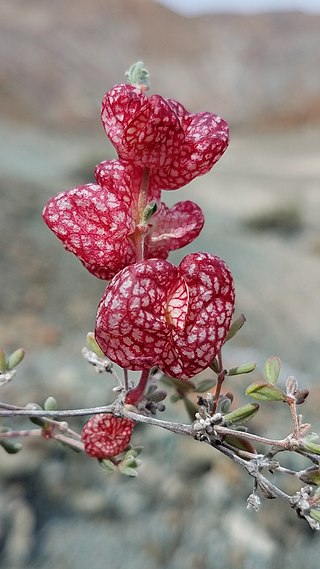
Harfordia macroptera is a woody perennial in the family Polygonaceae commonly known as rabbit's purse. It is the sole species in the genus Harfordia, which is endemic to the Baja California Peninsula. This plant is characterized by a unique, conspicuous bladder embellished with red to purple veins that surround the fruit. The sac-like structure is actually a dramatically modified bract, and assists in dispersal of the seeds through the wind.

Pachycormus is a monotypic genus of flowering plants in the cashew family commonly known as the Baja elephant tree, torote blanco, or copalquín. The single species Pachycormus discolor is endemic to the Baja California peninsula, with three varieties. This sarcocaulescent tree or shrub is characterized by its unique gnarled growth habit, skin-like exfoliating bark, and succulent nature, whose appearance has been colorfully described as "the proboscis of an elephant holding a nosegay," a "huge radish protruding from the ground," or "grotesque resemblances of the flexed limbs of a corpulent human being." This drought-deciduous species spends most of the year dormant, but following rains pinnate green leaves emerge, and in the late spring to summer the leaves yellow, fall, and give way to bright red, cream, or pink flowers that give it a striking appearance in bloom.

Salvia brandegeei is a perennial evergreen shrub in the mint family known by the common names Santa Rosa Island sage or Brandegee's sage. It is a fragrant plant characterized by lavender flowers and dark green leaves. For many years, it was thought to be native only to Santa Rosa Island, one of the Channel Islands of California, until it was discovered along the coast of Baja California. It is threatened by development and mining along the mainland portions of its range, but otherwise has a stable population on Santa Rosa Island.
Carterella is a monotypic genus of flowering plants in the family Rubiaceae. The genus contains only one species, viz. Carterella alexanderae, which is endemic to Baja California Sur in Mexico. It grows on steep slopes in the mountains.
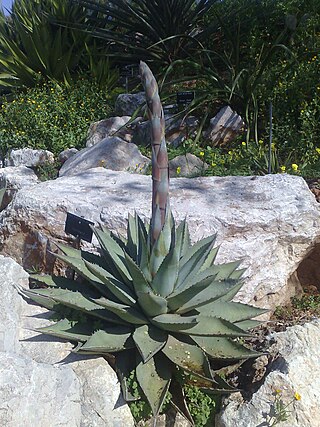
Agave margaritae is a species of plant from the Agave genus. Its common name in English is "Magdalena Island Agave".

Ferocactus diguetii, commonly known as the giant barrel cactus, is the largest species of barrel cactus in the genus Ferocactus. It is an insular species endemic to several of Baja California Sur's southern islands in the Gulf of California. As the superlative giant of the barrel cacti, it reaches heights of up to 4 metres (13 ft) and diameters of 1 metre (3.3 ft) in the wild, a result of island gigantism. The species has red flowers that bloom from March to May. Although restricted in range, this species grows in protected habitat and lacks major threats.
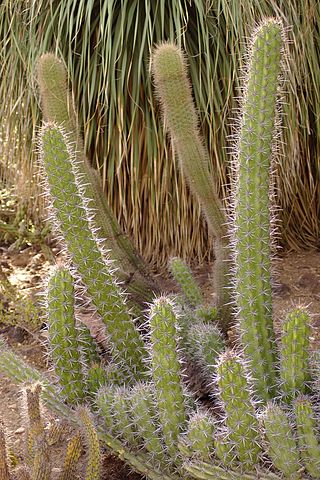
Stenocereus gummosus is a flowering plant in the family Cactaceae that is found in Baja California, Mexico at elevations of 9 to 134 meters
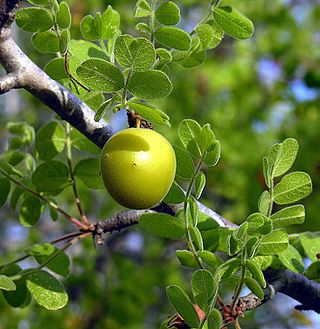
Cyrtocarpa edulis is a species of perennial sarcocaulescent tree commonly known as the Cimarrón plum or Cape wild-plum. It is in the genus Cyrtocarpa, and is endemic to Baja California Sur. This plant is characterized by fleshy stems, twisted branches and an edible drupe.

Xylonagra arborea is a flowering plant endemic to the western side of the Baja California Peninsula. It is a bushy shrub distinguished by showy, scarlet flowers that are attractive to hummingbirds. It is the sole species in the genus Xylonagra, which belongs to the family Onagraceae.

Dudleya pauciflora is a species of succulent plant in the stonecrop family known by the common name few-flower liveforever. It is characterized by its small crowded rosettes of narrow leaves and its colorful inflorescence with red-yellow flowers. Found growing on rocky outcrops and cliffs in the high elevation mountains of the Sierra de San Pedro Martir and the Sierra de San Borja, it is endemic to the state of Baja California, Mexico.

Gambelia is a genus of flowering plants in the Antirrhineae tribe of the plantain family commonly known as bush snapdragons. This genus is native to northwestern Mexico, particularly the Baja California Peninsula, but species are also found on the coast of Sonora, Guadalupe Island, and the Channel Islands of California. The genus is named in honor of William Gambel (1823–1849), an American naturalist, ornithologist, and botanist.

Dudleya nubigena is a species of succulent plants in the family Crassulaceae. It is a rosette forming perennial with flattish leaves. Endemic to southern Baja California Sur, the species is found in the Sierra de la Laguna and the surrounding lowlands, a small southern portion of the Sierra de la Giganta, and on Isla Espíritu Santo, with a subspecies endemic to Cerralvo Island.

Lysiloma candidum, most commonly known as the palo blanco, is a tree of the family Fabaceae near-endemic to the Baja California Peninsula in Mexico. It may grow to a height of 10 metres (33 ft) and is one of the few spineless woody legumes in the region. It has compound leaves with oval gray-green leaflets. The creamy-white, globose clusters of flowers bloom in March through May and perfume the air with a light, spicy fragrance. The flowers are followed by red-brown pods up to 15 centimetres (5.9 in) long that hang delicately on the thin branches. This species is distributed throughout the Baja California Peninsula, from Rancho El Barril in southern Baja California state to the Cape region of Baja California Sur, and is also very rarely found in the state of Sonora.
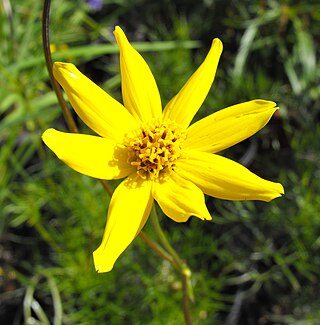
Bidens nudata is a species of perennial plant in the family Asteraceae commonly known as the Cape beggar's tick or Baja tickseed. This species is endemic to the Sierra de la Laguna and the Sierra de las Cacachilas of Baja California Sur, Mexico. It is characterized by a mounding habit, pinnate green leaves and large yellow daisy-like flowers. This species has found uses in horticulture as an ornamental, providing a drought-tolerant and durable plant for the garden.

Nolina beldingii is a species of perennial flowering plant in the family Asparagaceae known commonly as the Cape nolina or Belding's beargrass. It is an arborescent monocot growing up to 7 metres (23 ft) high, with fissured bark on a trunk topped with leaf rosettes. The narrow leaves are up to 1.15 m (3.8 ft) long, and are used as thatching by local peoples. This species is endemic to Baja California Sur in Mexico, where it grows only in the highest reaches of the Sierra de la Laguna. It is found primarily in oak forests at elevations over 1,000 m (3,300 ft) along rocky granite outcrops.

Lepechinia hastata is a rare species of perennial shrub in the mint family commonly known as the Cape pitcher sage or Baja pitcher sage. Lepechinia hastata is an aromatic shrub characterized by large, arrowhead-shaped leaves and attractive purple to magenta flowers. In the wild, it is known from the forested mountains of the Sierra de la Laguna in Baja California Sur and the volcanic Socorro Island in the Pacific Ocean, both part of Mexico. The plants of Socorro Island are their own subspecies, and differ in their white flowers and wooly, grayer foliage.

Schoepfia californica is a species of flowering plant in the Schoepfiaceae commonly known as the California schoepfia, iguajil, and candelillo. It is a large shrub or small tree with grayish bark, smooth turquoise-colored leaves, and small red flowers. It is endemic to the Baja California peninsula, and is commonly found in desert flats, slopes, and washes in an area from the Bahia de Los Angeles to the Cape region at the tip of the peninsula.
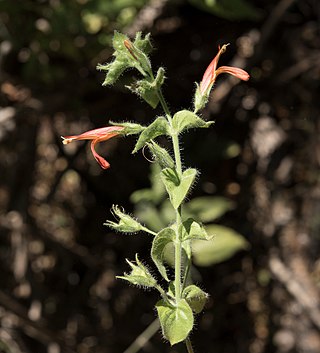
Justicia purpusii is a species of flowering plant in the Acanthus family commonly known as Purpus' hummingbird flower or chuparosa. This shrub is characterized by long orange-red tubular flowers that bloom from November to April. It is endemic to the Cape region of Baja California Sur, Mexico, where it is found growing in tropical deciduous forest and thorn scrub in canyons and along wet slopes. It is similar to its more northern relative adapted to drier climates, Justicia californica. Phylogenetic analysis has shown that both species are closely related and form a clade.

Dianthera incerta is a species of perennial herb in the Acanthus family commonly known as the Cape tube-tongue or chuparrosa. D. incerta is characterized by solitary, pink, two-lipped tubular flowers up to 27 mm (1.1 in) long that emerge from the leaf axils. It is endemic to the Cape region of Baja California Sur, as is the larger, shrubby, red-flowered Justicia purpusii. It is most similar to other species formerly placed in Siphonoglossa, such as Dianthera sessilis of the West Indies and South America.

Gambelia juncea is a species of flowering shrub in the plantain family commonly known as the Baja California bush snapdragon or Baja bush snapdragon. Gambelia juncea is a highly variable woody perennial to 1 m (3.3 ft) characterized by long, arching, reed-like stems and showy, bright red, two-lipped tubular flowers. Native to the Baja California peninsula and coastal Sonora, this species is widespread in the region across numerous habitats and has several varieties. It was formerly placed in the primarily South American genus Galvezia, but taxonomic studies have supported the reclassification of the two North American species into Gambelia. This species, with a number of cultivars, is widely used as an ornamental shrub for xeriscaping, erosion control, native plant gardens, and wildlife gardens.



















